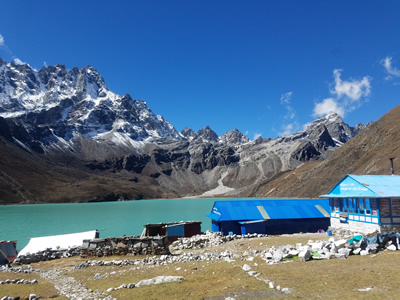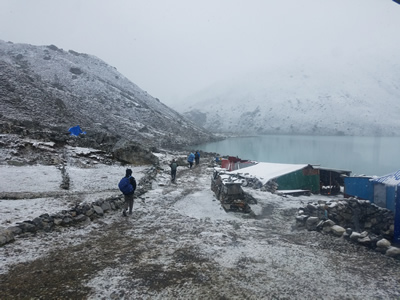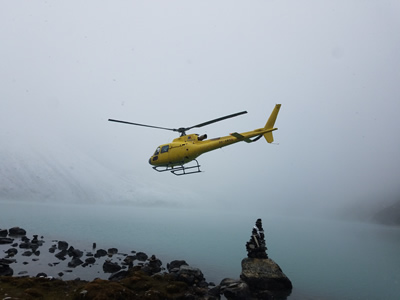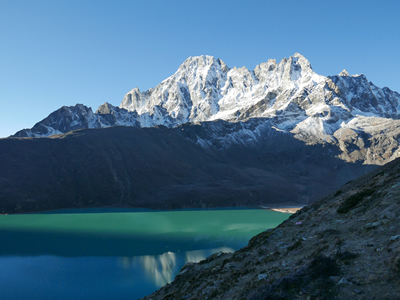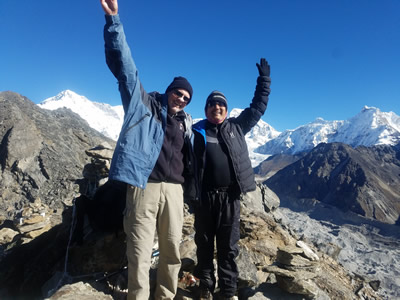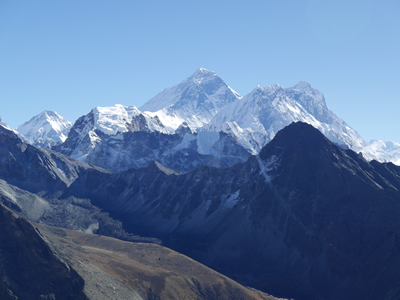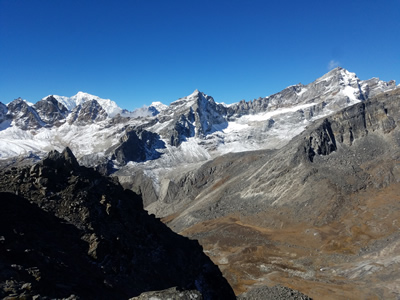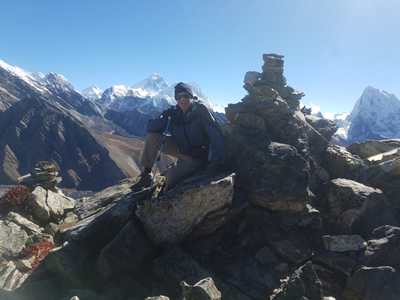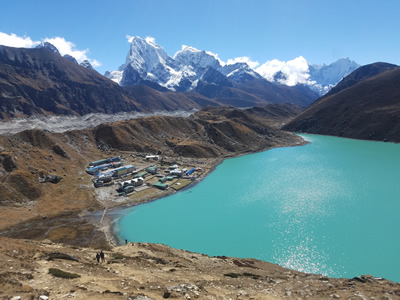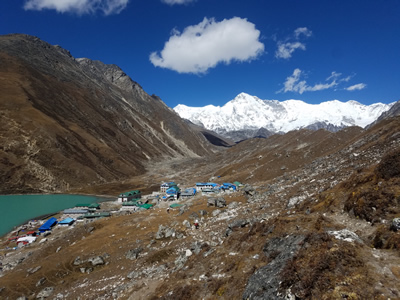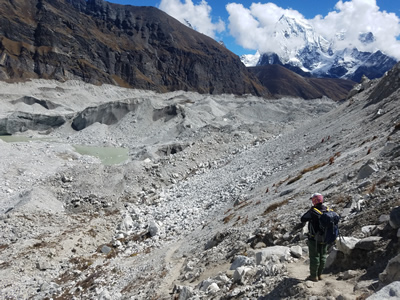Nepal Pt10: Climbing Gokyo Ri
After crossing the Renjo La we arrived at the village of Gokyo in the middle of the afternoon. At 15,715 feet it's a large village for being so high, but it'as grown to support the trekkers who come to the area. It has several lodges and even a bakery/coffee shop. It's on the shore of a beautiful emerald green glacial lake, Gokyo Tsho. Further up the valley is the massive south face of Cho Oyu, the sixth highest mountain in the world, while the view across the lake is dominated by 19,740 ft Phari Lapcha.
Nearby is Gokyo Ri, an unassuming hill that is 17,585 feet high, exactly the same height as the Renjo La. It's a world famous viewpoint, with views of Mt. Everest and other Himalayan giants. It's an easy walk up, at least as easy as anything can be that is over 17,000 feet high. There's a trail that starts at the lake and goes to the top. I climbed to the top of Gokyo Ri on my first trip to Nepal in 1990 and Shambu and I were here to try again.
Since there were several teahouses in Gokyo we had to decide where to stay. We took a quick look around and picked one. Turned out it was full. We tried another one. It was full too. Since I was pretty tired Shambu told me to sit by the lake while he found a place for us. He came back and said he had finally found a spot at the Mountain View Lodge. At least we didn't have to agonize over which place to pick.
This wasn't exactly the best of all the places that we stayed at on this trek. It had a western-style toilet but it was missing the seat. It had a hot shower but it was broken. There were no outlets in the rooms so I had to pay five bucks to charge my phone. It had been two days since I charged it in Thame and the battery was just about dead. The one good thing about this place was that the sleeping rooms did have plenty of blankets. Since it was cold at night this high up that was important. So in my mind the lodge was good enough.
The weather on this trip had followed a pattern. Even when the mornings were clear, clouds started to build up during the morning. By noon the mountains were usually socked in. To make sure that we would have good views from the top of Gokyo Ri tomorrow, we decided to leave very early. Shambu and I got up at 4:30 am, which felt like the middle of the night, and went outside to check the weather. Not good. It was overcast and snowing. We decided to cancel the climb and went back to bed.
I got up again at seven and had breakfast. Outside it was still foggy and it was still snowing. It was cold too. We weren't going up Gokyo Ri today. In fact it wasn't a very good day to go anywhere. We decided that we would take a rest day and stay in Gokyo. Hopefully the weather would clear the next day and we could still climb Gokyo Ri. There wasn't much to do so I went back to bed again. At least it was warm under all the blankets and I was worn out from yesterday's tough hike over the Renjo La. This time I slept until ten.
I was in the dining room most of the day. The sleeping rooms were in a separate building which wasn't heated. They were uncomfortably cold when you weren't in bed under a pile of blankets.
I spent most of the day reading. I had been doing a lot of reading on this trip. At the beginning when I was waking up before dawn, I would read till it got light. Later I read in the evening after dinner. Today I had a whole day with nothing to do but read.
I finished two books on the trip. The first was The Greatest Story Ever Told - SoFar: Why Are We Here by Lawrence Krauss. It's a popular physics book that describes the history leading to modern cosmology and the standard model of particle physics. I had already finished it by the time we reached Gokyo. Good light reading (-:
At Gokyo I was reading The Centurians by Jean Larteguy. It's a novel about the French colonial wars in Indochina and Algeria in the 1950's and 1960's. I developed an interest in those conflicts from some of the wargames I have played, like Storm Over Dien Bien Phu and Colonial Twilight. I think the history of the period is fascinating. I did appreciate the irony of reading about French soldiers fighting in the jungles of Vietnam while I was bundled up in my down jacket and huddled next to an iron stove.
In the old days when I took books along on a trek, as I read pages I would tear them out to save weight. This time I brought my Kindle ereader so I could bring as many books along as I wanted. Although I have a Kindle Fire and love it, I took my old Kindle 2 on this trip. It was a gift from my son Tim way back in 2009 and it still works fine. Because it doesn't have an active display it's much better for travel. It's easier to read in high ambient light so it's great on beach vacations. The battery lasts just about forever with wireless turned off so I could go over two weeks on this trek without needing to charge it.
There was a big iron stove in the center of the dining room. Even with a fire going in it the room was cold. I wore my down jacket and a warm hat all afternoon. Reading isn't an activity that generates a lot of body heat. Whenever someone got cold they would pull their chair a little closer to the center of the room. By the middle of the afternoon Shambu, Awshuk and I were all sitting right next to the stove with our feet propped up on it.
There was a little excitement that afternoon. We heard a helicopter flying over, very low. We rushed outside and saw it land just outside the village. It was quite surprising because although it had stopped snowing there was still heavy fog. I couldn't see any of the mountains that surrounded the village. That's a problem because there are mountains all around Gokyo. Because they are so high, you can't fly over them. A helicopter has to approach up the narrow valley that comes up from Namche. To use an old pilot's expression, the clouds around here have rocks in them.
We saw two people get into the helicopter. It took off, headed towards Namche and disappeared into the clouds. We heard later that it was an evacuation. The people picked up had serious altitude sickness. That can be life threatening when you are as high up as we were at Gokyo. The pilot had to be brave to fly the rescue though. Or crazy. Everyone knows the old saying.
There are old pilots and there are bold pilots, but there are no old, bold pilots.
Something at breakfast or lunch didn't agree with me. My stomach was irritated so I skipped dinner. That got Shambu worried again. My sinus infection felt like it was coming back too. I was kind of a mess but I didn't say anything. Shambu and I decided to get up at 4:30 am again tomorrow. It would be our last chance to climb Gokyo Ri. If the weather wasn't good enough for an attempt we would have to leave anyway. We would need all of our remaining days to walk back to Lukla in time to catch our flight to Kathmandu.
At 4:30 Shambu and I went outside. It was still cloudy. Reluctantly we decided to cancel the attempt on Gokyo Ri again and go back to bed. I was seriously bummed. I had a headache to boot and couldn't go back to sleep. I finally got up again at 6 am. I looked out the window and the sky was clear! I got dressed and went out in the hallway and ran into Shambu. He had gotten up too and seen that it was clear and was on his way to wake me up. It was later than we planned to leave but we wanted to go for it.
I was like a little kid who stays home sick from school, then at three oclock is miraculously cured and wants to go out and play. All of my aches and pains and illnesses were immediatly forgotten. I got ready as fast as I could. In fifteen minutes we were ready to rock and roll.
A lot of other people were heading up too. There were a few people who had started earlier who were ahead of us. As we climbed there were a lot more people who came after us. Since I was slow, as usual, a lot of them passed us.
Bistari, bistari.
This time I did feel a sense of urgency to get to the top. I really wanted to have a good view and was worried that clouds could form again any time. Because of the cold weather I had a lot of extra warm clothes in my pack. Shambu was wearing all of his stuff and only had a fanny pack so he offered again to take my pack. I gave it to him. I hated to do it but I really felt like we had to make the best time we could up the hill and I was the slow one.
Most people stopped at a viewpoint a little below the top but we went all the way to the true summit. I am somewhat of a mountaineering purist after all (says the guy who wasn't even carrying his own pack). It was 1870 feet of elevation gain from our lodge to the top of Gokyo Ri. We made it in two hours and fifteen minutes. I felt really strong, like it was just an ordinary hike, even though we were at 17,585 feet, the same height as the Renjo La. It was amazing what a difference those two extra days of acclimatization made.
There wasn't a cloud in the sky when we reached the top. I was about as happy as I could be. We had gone from a washout to complete success on our biggest objective of the trip in just a few hours.
The view was as amazing as I had remembered it to be. All around us were some of the highest and most spectacular mountains on earth.
Mt. Everest was clearly visible about fifteen miles away. It isn't the most beautiful mountain but it is striking. It gives the unmistakable impression of being very high, higher than anything else anywhere around it. It's called Sagarmantha in Nepali and gives it's name to the national park that protects it. But I prefer the Sherpa name for the mountain, Chomolungma, the Goddess Mother of Earth. She rises high above the mountains around her, all of them giant mountains in their own right.
There were many other spectacular peaks. I could see Lhotse, Makalu and Cho Oyu, the fourth, fifth and sixth highest mountains on the planet. That made a total of four of the fourteen mountains over 8000 meters in height that were visible from where we were standing. I identified Gyachung Kang, Cholatse, Nuptse, Changtse and Tabuche, all famous and incredibly beautiful mountains. There were many more that I did not recognize but were spectacular none the less. Gokyo Ri has one of the most fantastic views I have ever seen.
I took lots of photos. Then Shambu took some of me with the mountains as a backdrop. Another trekker took a shot of Shambu and I together, celebrating our success in reaching the top. We stayed on top a long time.
The trip down was easy. I was so excited that I felt like I was floating all the way down. Although not as expansive, the views were still spectacular. There was Gokyo Lake at the base of the steep face of Phari Lapcha. The incredible pyramid of Cholatse towered over the village of Gokyo. It seemed like no time at all before we were down the hill and back in Gokyo at the Mountain Lodge again. Our morning workout had made me hungry and I was ready for lunch.
After eating we had to hike to the tiny village of Dragnag. Most of the way was across the Ngozumba Glacier, a huge river of ice that flows down from Cho Oyu. It's twenty two miles long, the longest glacier in the Himalayas. Although there was virtually no net elevation change, the surface of the glacier was extremely broken up so that we were always hiking up or down. It was two and a half hours of hard walking but I didn't mind. I was really happy because I had climbed a seventeen thousand foot peak in the Himalaya.
Twice!!!
